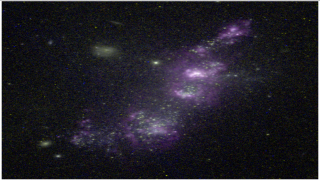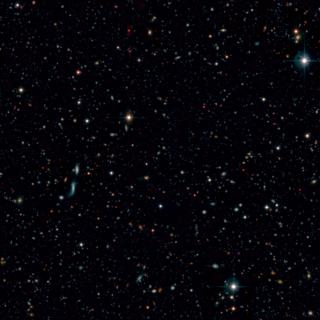Zamorano, Jaime; Trujillo, I.; Tresse, Laurence; Rodríguez-Zaurín, J.; Renzini, Alvio; Muñoz-Tuñón, C.; Hernán-Caballero, Antonio; Guzmán, Rafael; González-Martín, O.; Gobat, R.; Gallego, Jesús; Espino, Néstor; Elbaz, David; Donley, Jennifer; Daddi, Emmanuele; Conselice, Christopher J.; Cimatti, Andrea; Charlot, Stéphane; Cepa, J.; Cenarro, Javier; Balcells, M.; Alonso-Herrero, Almudena; Rodríguez-Espinosa, J. M.; Ferreras, Ignacio; Cardiel, Nicolás; Villar, Víctor; Barro, Guillermo; Cava, Antonio; Pérez-González, Pablo G.
Referencia bibliográfica
The Astrophysical Journal, Volume 762, Issue 1, article id. 46, 24 pp. (2013).
Fecha de publicación:
1
2013
Revista
Número de citas
113
Número de citas referidas
101
Descripción
We present the Survey for High-z Absorption Red and Dead Sources
(SHARDS), an ESO/GTC Large Program carried out using the OSIRIS
instrument on the 10.4 m Gran Telescopio Canarias (GTC). SHARDS is an
ultra-deep optical spectro-photometric survey of the GOODS-N field
covering 130 arcmin2 at wavelengths between 500 and 950 nm
with 24 contiguous medium-band filters (providing a spectral resolution
R ~ 50). The data reach an AB magnitude of 26.5 (at least at a 3σ
level) with sub-arcsec seeing in all bands. SHARDS' main goal is to
obtain accurate physical properties of intermediate- and high-z galaxies
using well-sampled optical spectral energy distributions (SEDs) with
sufficient spectral resolution to measure absorption and emission
features, whose analysis will provide reliable stellar population and
active galactic nucleus (AGN) parameters. Among the different
populations of high-z galaxies, SHARDS' principal targets are massive
quiescent galaxies at z > 1, whose existence is one of the major
challenges facing current hierarchical models of galaxy formation. In
this paper, we outline the observational strategy and include a detailed
discussion of the special reduction and calibration procedures which
should be applied to the GTC/OSIRIS data. An assessment of the SHARDS
data quality is also performed. We present science demonstration results
on the detection and study of emission-line galaxies (star-forming
objects and AGNs) at z = 0-5. We also analyze the SEDs for a sample of
27 quiescent massive galaxies with spectroscopic redshifts in the range
1.0 < z <~ 1.4. We discuss the improvements introduced by the
SHARDS data set in the analysis of their star formation history and
stellar properties. We discuss the systematics arising from the use of
different stellar population libraries, typical in this kind of study.
Averaging the results from the different libraries, we find that the
UV-to-MIR SEDs of the massive quiescent galaxies at z = 1.0-1.4 are well
described by an exponentially decaying star formation history with scale
τ = 100-200 Myr, age around 1.5-2.0 Gyr, solar or slightly sub-solar
metallicity, and moderate extinction, A(V) ~ 0.5 mag. We also find that
galaxies with masses above M* are typically older than lighter galaxies,
as expected in a downsizing scenario of galaxy formation. This trend is,
however, model dependent, i.e., it is significantly more evident in the
results obtained with some stellar population synthesis libraries, and
almost absent in others.
Proyectos relacionados

Grupo de Estudios de Formación Estelar GEFE
El proyecto interno GEFE está enmarcado en el proyecto coordinado, ESTALLIDOS, financiado por el plan nacional desde el año 2001. El ultimo proyecto aprobado es ESTALLIDOS 6.0 (AYA2016- 79724-C4-2-P). En el proyecto GEFE trabajamos en base al caso científico del proyecto ESTALLIDOS 6.0. Los estallidos de formación estelar (Starbursts o SB) son
Casiana
Muñoz Tuñón

Huellas de la Formación de las Galaxias: Poblaciones estelares, Dinámica y Morfología
Bienvenida a la página web del g rupo de investigación Traces of Galaxy Formation. Somos un grupo de investigación amplio, diverso y muy activo cuyo objetivo principal es entender la formación de galaxias en el Universo de una manera lo más completa posible. Con el estudio detellado de las poblaciones estelares como bandera, estamos constantemente
Anna
Ferré Mateu

Evolución de Galaxias
El estudio de la evolución de las galaxias es un tema crucial de la Astronomía Extragaláctica moderna. Permite vincular las galaxias locales con las primeras que existieron en el universo. Pero para poder abordarlo es preciso obtener censos estadísticamente significativos de galaxias de distintas luminosidades, a distintas distancias
Jorge
Cepa Nogue